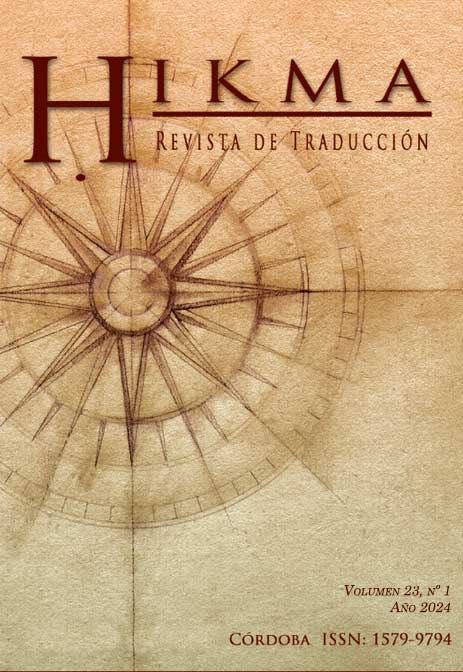ZÁRATE, Soledad. Captioning and subtitling for d/deaf and hard of hearing audiences. Londres, UCL Press, 2021, 154 pp., 978-1-78735-712-9.
Contenu principal de l'article
Résumé
Review of the book: Captioning and Subtitling for d/Deaf and Hard of Hearing Audiences.
Téléchargements
Details de l'article

Ce travail est disponible sous licence Creative Commons Attribution - Pas d’Utilisation Commerciale - Partage dans les Mêmes Conditions 4.0 International.
Les auteurs qui publient dans cette revue acceptent les conditions suivantes :
- Les auteurs conservent les droits d'auteur et accordent à la revue le droit de première publication du travail simultanément sous une Licence Creative Commons Attribution, permettant à d'autres de partager le travail en reconnaissant la paternité du travail et sa publication initiale dans cette revue.
- Les auteurs peuvent conclure des accords contractuels supplémentaires séparément pour la distribution non exclusive de la version publiée du travail dans la revue (par exemple, l'envoyer à un référentiel institutionnel ou le publier dans un livre), avec une reconnaissance de sa publication initiale dans cette revue.
- Il est permis et encouragé aux auteurs de publier leurs travaux en ligne (par exemple, dans des référentiels institutionnels ou sur leur site Web) avant et pendant le processus de soumission, car cela peut entraîner des échanges productifs, ainsi qu'une citation plus précoce et plus importante du travail publié (voir L'effet de l'accès ouvert).
Références
Agulló, B., & Matamala, A. (2019). Subtitling for the deaf and hard-of-hearing in immersive environments: Results from a focus group. The Journal of Specialised Translation, 32, 217-235.
Arnáiz, V. (2012). Los parámetros que identifican el subtitulado para sordos: Análisis y clasificación. MonTI. Monografías de Traducción e Interpretación, 4, 103–132. https://doi.org/10.6035/MonTI.2012.4.5 DOI: https://doi.org/10.6035/MonTI.2012.4.5
De Linde, Z., & Kay, N. (1999). The Semiotics of Subtitling. St Jerome.
Díaz-Cintas, J., & Remael, A. (2021). Subtitling: Concepts and practices. Routledge. DOI: https://doi.org/10.4324/9781315674278
Ivarsson, J., & Carroll, M. (1998). Subtitling. TransEdit.
Ley 13/2022, de 7 de julio, General de Comunicación Audiovisual., 13/2022 Boletín Oficial de Estado, 163, de 8 de julio de 2022. https://www.boe.es/eli/es/l/2022/07/07/13/con
Miquel-Iriarte, M. (2017). The reception of subtitling for the deaf and hard of hearing: Viewers’ hearing and communication profile & subtitling speed of exposure. [Doctoral dissertation, Universitat Autònoma de Barcelona].
Neves, J. (2005). Audiovisual translation: Subtitling for the deaf and hard-of-hearing. [Doctoral dissertation, University of Roehampton].
Palacios, A. (2008). El modelo social de discapacidad: Orígenes, caracterización y plasmación en la Convención Internacional sobre los derechos de las personas con discapacidad. Cinca.
Romero-Fresco, P. (Ed.). (2015). The reception of subtitles for the deaf and hard of hearing in Europe. Peter Lang. DOI: https://doi.org/10.3726/978-3-0351-0888-0
Romero-Fresco, P., & Fresno, N. (2023). The accuracy of automatic and human live captions in English. Linguistica Antverpiensia, New Series: Themes in Translation Studies, 22, 114–133. https://doi.org/10.52034/lans-tts.v22i.774 DOI: https://doi.org/10.52034/lans-tts.v22i.774
Sala, È. (2022). Rendering tone and mood in creative subtitles for deaf and hard-of-hearing: A proposal. Między Oryginałem a Przekładem, 28(1 (55), 73–91. https://doi.org/10.12797/MOaP.28.2022.55.04 DOI: https://doi.org/10.12797/MOaP.28.2022.55.04
Szarkowska, A. (2020). Subtitling for the deaf and the hard of hearing. In Ł. Bogucki & M. Deckert (Eds.), The Palgrave Handbook of Audiovisual Translation and Media Accessibility (pp. 249–268). Springer International Publishing. https://doi.org/10.1007/978-3-030-42105-2_13 DOI: https://doi.org/10.1007/978-3-030-42105-2_13
Wilmington, A. (2017). Deaf like me. Engaging ‘hard to reach’ deaf audiences through theatre. Red Earth Theatre.
Zárate, S. (2014). Subtitling for deaf children: Granting accessibility to audiovisual programmes in an educational way. [Doctoral dissertation, University College London].

